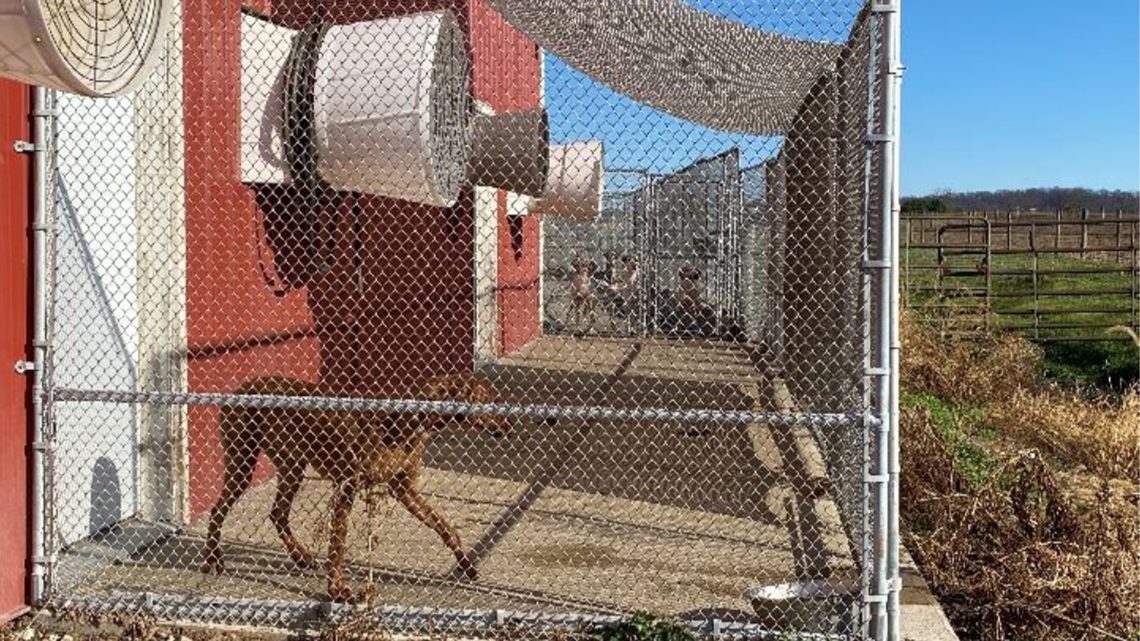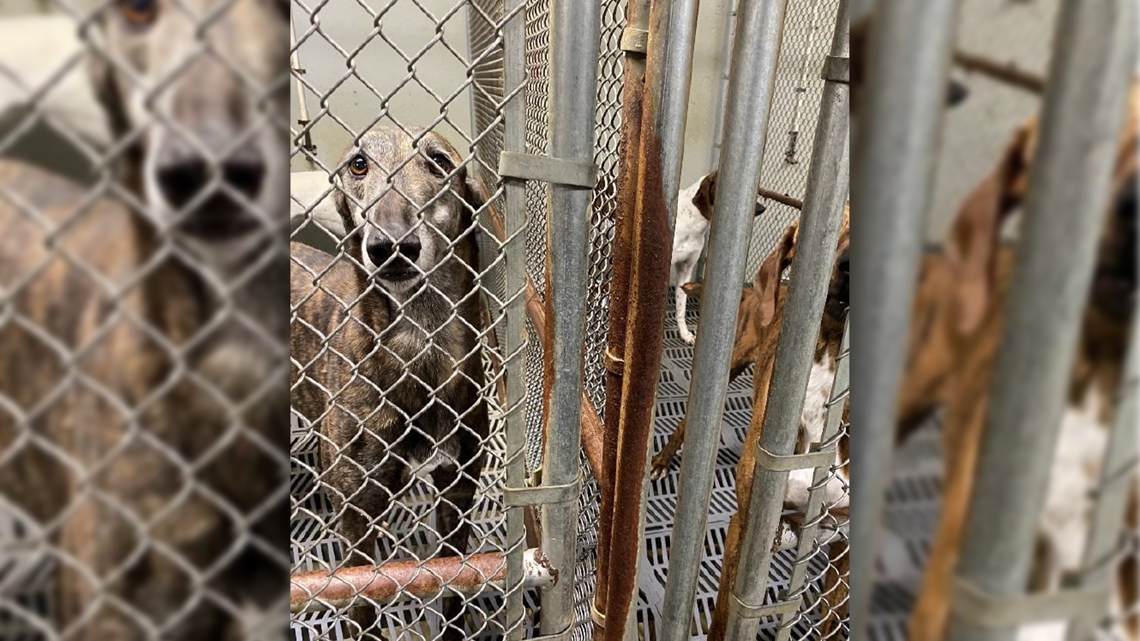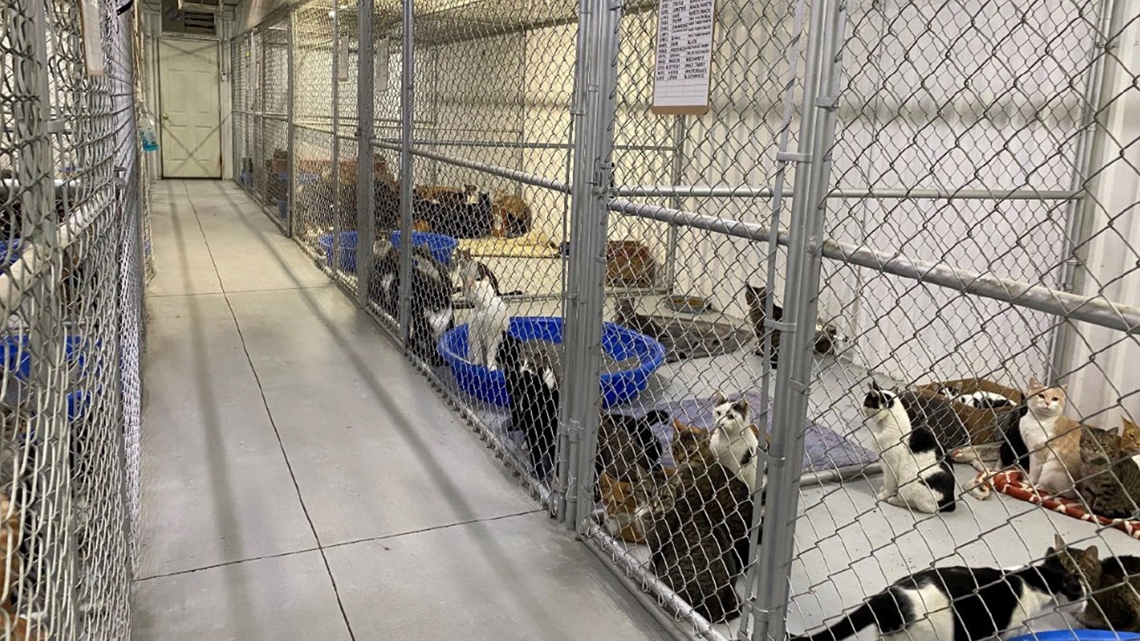A dog and cat blood bank in southern Indiana has sparked protest and outrage among animal activists.
JACKSON COUNTY, Ind. — If you’re a dog or cat owner and you’ve had to rush your beloved pet to a veterinary hospital in an emergency, you’ve experienced that tremendous sense of relief when your pet received the care they needed to get better.
Sometimes, those emergencies require a blood transfusion, and that blood is continually a challenge to come by.
Like for humans, there are blood banks set up to draw blood from dogs and cats, albeit that type of blood bank is much more limited.
In Jackson County, Indiana, a large operation pumps out a lot of blood for the supply chain.
The Veterinarians’ Blood Bank (TVBB) is split into two blood drawing facilities: hundreds of dogs in Vallonia and hundreds of cats in Brownstown.

Officially registered as a commercial breeder, the animals at TVBB don’t come and go; they are there to stay.
“They’re engaged in breeding animals who they then bleed for profit,” Dan Paden, the vice president of Evidence Analysis with People for the Ethical Treatment of Animals (PETA), said.
PETA said it secretly infiltrated TVBB with one of its members getting hired onto the staff.
In the complaints, PETA complained of cruel conditions inside the pet blood bank, including accusations that staff repeatedly drew blood from old and even sick animals.
On Dec. 27, a BOAH veterinarian made an unannounced inspection at the dog blood bank and also inspected the cat blood bank.
Dog and cat facilities
Dr. Jodi Lovejoy noted that at the dog operation, “retired dogs remain on property” while “puppies born on the property are retained on property as replacements.”
“They even deny animals the small mercy of a proper retirement,” Paden complained. “They stay there until they die.”
In her report, Lovejoy stated that at the time there were 340 dogs on site with some having significant dental problems.
There were also some dogs with skin injuries with several cages lacking solid floor and bedding.


Other enclosures also had rust needing to be addressed.
Her report reveals that TVBB draws blood from dogs every three weeks, sometimes a day or two earlier, and that dogs are retired at around 10 years old with at least two dogs retired at 12 years old.
For reference, Lovejoy included information from other donor programs, as well as from dvm360, which is a veterinary publication.
As noted in the report, dvm360 suggests at least three to four weeks between blood draws for commercially owned dogs.
However, at Ohio State University’s Veterinary Medical Center, the standard is to spread out blood draws every two months, while dogs start at a year old and retire at 6 years old.
With other donor programs, Lovejoy noted, dogs age out by 7 or 8 years old.
Upon inspection of the cat facility, Lovejoy reported 581 cats on site with about 15 cats per kennel; however, she stated there were no signs of unattended injuries or illnesses and that the cats didn’t appear to be in jeopardy.
Lovejoy found the cats are 9 months old and 8 pounds when they start with blood draws, which happen every three weeks, and the cats are retired at 10 to 11 years old.


She also noted dvm360 suggests minimum age and weight should be 1 years old and 10 pounds with retirement by 8 years old.
Standards at Ohio State University’s Veterinary Medical Center are more restrictive.
Although weight is also 10 pounds, a cat’s age range in the program is 1 to 6 years old, and blood collection every eight weeks at most.
“Three weeks is not dangerous,” Dr. Dana LeVine said. “On a routine basis that wouldn’t be ideal.”
Pets donating blood
LeVine, a veterinarian, is president of the Association of Veterinary Hematology & Transfusion Medicine (AVHTM).
She also runs the pet blood bank at Auburn University’s vet school, which is a volunteer or community-based blood bank.
That means pet owners bring their dogs and cats in for blood donations.
“In general, you don’t want to donate a dog or a cat too frequently,” LeVine advised. “If you’re donating them too frequently, they can definitely become anemic.”
At her blood bank, dog donors have to be at least 50 pounds and 1 to 6 years old.
LeVine stressed the pet blood bank industry needs uniform standards and guidelines, and AVHTM is working on recommendations.
“We want to make sure that we’re doing the right thing, that we are treating our donors appropriately, that we’re not putting donors at any risk to give blood, that we’re handling blood appropriately so that when a recipient receives blood, they’re not going to end up with an infection or a reaction that could have been prevented,” she said.
LeVine acknowledged that closed colonies are responsible for much of the pet blood supply chain, and when comparing them with community-based blood banks, she says “I think that they can both be done very well.”
However, it’s clear why one type of donation operation is less controversial than the other.
“It’s nice to have animals be able to live in their own homes,” LeVine said.
That’s exactly how the blood bank is set up at Jefferson Animal Hospital in Louisville.
“They should be home on the couch, being couch potatoes, and getting to run and play outside, and that should be a normal life,” Sara Kinnett, the blood bank manager, said.
About 75 dogs and 40 cats are in the donation program at Jefferson Animal Hospital, but the facility could always use more.
“There are times where other hospitals will call and we just don’t have enough to send out,” Kinnett said.
After the PETA report, certain veterinary hospitals stopped buying blood from The Veterinarians’ Blood Bank, including Blue Pearl, which issued this online statement:
If you can’t see the above documents, click here.
Kinnett says there has been an uptick in demand for her facility’s blood, but reaffirms “Jefferson Animal Hospital will always be the priority.”
At Jefferson Animal Hospital, donor dogs must be up to date with vaccines and monthly preventatives, should ideally be 50 pounds, and donations usually occur every 8 to 12 weeks.
Luna, a coveted universal donor as a greyhound, was transitioning out of the program as an 8 year old.
When we met Luna, it was her 30th donation over 6 years in the program.
The trade-off has been treats for her, while her owner, Jason Friedman, has benefited by saving money.
Among several things, Jefferson Animal Hospital will cover costs of yearly exams, lab work, and main vaccinations.
“Honestly, even if it wasn’t a part of the program, I probably would still do it anyway,” Friedman said. “I’ve told her, she’s a good girl, she’s helped save many of her doggy friends over the years.”
Friedman feels Jefferson Animal Hospital does it the right way.
“Just like humans, it should be voluntary,” Friedman said.
That’s how PETA wants pet blood banking done nationwide.
“PETA doesn’t oppose in the least blood transfusion medicine for animals, it’s very important, it’s vital, it saves lives,” Paden said. “What we’re opposed to is breeding and keeping animals in cages their entire lives simply to take their blood.”
The Veterinarians’ Blood Bank declined an on-camera interview and would not provide a statement. However, a man who identified himself as Dr. Ron Harrison, one of the owners, told FOCUS outside the dog facility that they are now trying to adopt out retired dogs through “Prison Greyhounds.”
The Indianapolis-based organization confirmed that so far they’ve managed to find new homes for a few dogs from TVBB.
Make it easy to keep up-to-date with more stories like this. Download the WHAS11 News app now. For Apple or Android users.
Have a news tip? Email assign@whas11.com, visit our Facebook page or Twitter feed.
